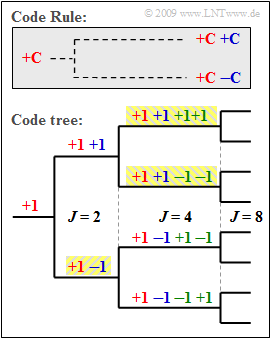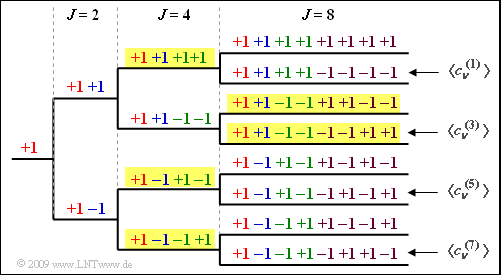Difference between revisions of "Aufgaben:Exercise 3.8: OVSF Codes"
m (Javier moved page Exercises:Exercise 3.8: OVSF Codes to Exercise 3.8: OVSF Codes: Text replacement - "Exercises:Exercise" to "Aufgaben:Exercise") |
|||
| Line 4: | Line 4: | ||
[[File:EN_Mob_A_3_9.png|right|frame|Baumstruktur zur Konstruktion <br>eines OVSF–Codes]] | [[File:EN_Mob_A_3_9.png|right|frame|Baumstruktur zur Konstruktion <br>eines OVSF–Codes]] | ||
| − | + | The spreading codes for UMTS should | |
| − | *orthogonal | + | *be orthogonal, in order to avoid mutual influence of the participants, |
| − | * | + | *at the same time also allow a flexible realization of different spreading factors $J$ . |
| − | + | An example are the ''orthogonal Variable Spreading Factor'' (OVSF),which provide the spreading codes of lengths from $J = 4$ to $J = 512$ . | |
| − | + | As shown in the graphic, these can be created with the help of a code tree. In doing so, each branching from a code $\mathcal{C}$ results in two new codes $(+\mathcal{C}\ +\mathcal{C})$ und $(+\mathcal{C} \ –\mathcal{C})$. | |
| − | + | The diagram illustrates the principle given here using the following example $J = 4$. If you number the spreading sequences from $0$ to $J –1$ through, the spreading sequences result | |
:$$\langle c_\nu^{(0)}\rangle = \ {+\hspace{-0.05cm}1}\hspace{0.15cm} {+\hspace{-0.05cm}1} \hspace{0.15cm} {+\hspace{-0.05cm}1}\hspace{0.15cm} {+\hspace{-0.05cm}1} \hspace{0.05cm},$$ | :$$\langle c_\nu^{(0)}\rangle = \ {+\hspace{-0.05cm}1}\hspace{0.15cm} {+\hspace{-0.05cm}1} \hspace{0.15cm} {+\hspace{-0.05cm}1}\hspace{0.15cm} {+\hspace{-0.05cm}1} \hspace{0.05cm},$$ | ||
:$$ \langle c_\nu^{(1)}\rangle = {+\hspace{-0.05cm}1}\hspace{0.15cm} {+\hspace{-0.05cm}1} \hspace{0.15cm} {-\hspace{-0.05cm}1}\hspace{0.15cm} {-\hspace{-0.05cm}1} \hspace{0.05cm},$$ | :$$ \langle c_\nu^{(1)}\rangle = {+\hspace{-0.05cm}1}\hspace{0.15cm} {+\hspace{-0.05cm}1} \hspace{0.15cm} {-\hspace{-0.05cm}1}\hspace{0.15cm} {-\hspace{-0.05cm}1} \hspace{0.05cm},$$ | ||
| Line 19: | Line 19: | ||
:$$ \langle c_\nu^{(3)}\rangle = {+\hspace{-0.05cm}1}\hspace{0.15cm} {-\hspace{-0.05cm}1} \hspace{0.15cm} {-\hspace{-0.05cm}1}\hspace{0.15cm} {+\hspace{-0.05cm}1} \hspace{0.05cm}.$$ | :$$ \langle c_\nu^{(3)}\rangle = {+\hspace{-0.05cm}1}\hspace{0.15cm} {-\hspace{-0.05cm}1} \hspace{0.15cm} {-\hspace{-0.05cm}1}\hspace{0.15cm} {+\hspace{-0.05cm}1} \hspace{0.05cm}.$$ | ||
| − | + | According to this nomenclature, for the spreading factor $J = 8$ there are the spreading sequences $\langle c_\nu^{(0)}\rangle, \text{...} ,\langle c_\nu^{(7)}\rangle.$ | |
| − | + | It should be noted that no predecessor or successor of a code may be used by other participants. | |
| − | * | + | *In the example, four spreading codes with spreading factor $J = 4$ could be used, or |
| − | * | + | *the three codes highlighted in yellow - once with $J = 2$ and twice with $J = 4$. |
| Line 31: | Line 31: | ||
| − | '' | + | ''Notes:'' |
| − | * | + | *This task belongs to the chapter [[Modulationsverfahren/Spreizfolgen_für_CDMA|Spreizfolgen für CDMA]]. |
| − | * | + | *Particular reference is made to the page [[Modulationsverfahren/Spreizfolgen_für_CDMA#Codes_mit_variablem_Spreizfaktor_.28OVSF.E2.80.93Code.29|Codes mit variablem Spreizfaktor (OVSF–Code)]]. |
| Line 41: | Line 41: | ||
<quiz display=simple> | <quiz display=simple> | ||
| − | { | + | {Construct the tree diagram for $J = 8$. What are the resulting OVSF codes? |
|type="[]"} | |type="[]"} | ||
+ $\langle c_\nu^{(1)}\rangle = +\hspace{-0.05cm}1 \ +\hspace{-0.08cm}1 \ +\hspace{-0.08cm}1 \ +\hspace{-0.08cm}1 \ -\hspace{-0.08cm}1 \ -\hspace{-0.08cm}1 \ -\hspace{-0.08cm}1 \ -\hspace{-0.08cm}1$, | + $\langle c_\nu^{(1)}\rangle = +\hspace{-0.05cm}1 \ +\hspace{-0.08cm}1 \ +\hspace{-0.08cm}1 \ +\hspace{-0.08cm}1 \ -\hspace{-0.08cm}1 \ -\hspace{-0.08cm}1 \ -\hspace{-0.08cm}1 \ -\hspace{-0.08cm}1$, | ||
| Line 48: | Line 48: | ||
+ $\langle c_\nu^{(7)}\rangle = +\hspace{-0.05cm}1 \ -\hspace{-0.08cm}1 \ -\hspace{-0.08cm}1 \ +\hspace{-0.08cm}1 \ -\hspace{-0.08cm}1 \ +\hspace{-0.08cm}1 \ +\hspace{-0.08cm}1 \ -\hspace{-0.08cm}1$. | + $\langle c_\nu^{(7)}\rangle = +\hspace{-0.05cm}1 \ -\hspace{-0.08cm}1 \ -\hspace{-0.08cm}1 \ +\hspace{-0.08cm}1 \ -\hspace{-0.08cm}1 \ +\hspace{-0.08cm}1 \ +\hspace{-0.08cm}1 \ -\hspace{-0.08cm}1$. | ||
| − | { | + | {How many UMTS users can be served with $J = 8$ at maximum? |
|type="{}"} | |type="{}"} | ||
$K_{\rm max} \ = \ $ { 8 } | $K_{\rm max} \ = \ $ { 8 } | ||
| − | { | + | {How many users can be supplied with $J = 8$ if three of them should use a spreading code with $J = 4$ ? |
|type="{}"} | |type="{}"} | ||
$K \ = \ $ { 5 } | $K \ = \ $ { 5 } | ||
| − | { | + | {The tree structure applies to $J = 32$. Is the following assignment feasible: <br>twice $J = 4$, once $J = 8$, once $J = 164$ and eight times $J = 32$? |
|type="()"} | |type="()"} | ||
| − | + | + | + Yes. |
| − | - | + | - No. |
</quiz> | </quiz> | ||
| Line 67: | Line 67: | ||
[[File:P_ID2263__Bei_A_4_6a.png|right|frame|OVSF–Baumstruktur für $J = 8$]] | [[File:P_ID2263__Bei_A_4_6a.png|right|frame|OVSF–Baumstruktur für $J = 8$]] | ||
| − | '''(1)''' | + | '''(1)''' The following graphic shows the OVSF tree structure for $J = $8 users. |
| − | * | + | *From this it can be seen that the <u>solutions 1, 3 and 4</u> apply, but not the second. |
| − | '''(2)''' | + | '''(2)''' If each user is assigned a spreading code with the spreading degree $J = 8$, $K_{\rm max} \ \underline{= 8}$ subscribers can be supplied. |
Revision as of 22:38, 7 July 2020
The spreading codes for UMTS should
- be orthogonal, in order to avoid mutual influence of the participants,
- at the same time also allow a flexible realization of different spreading factors $J$ .
An example are the orthogonal Variable Spreading Factor (OVSF),which provide the spreading codes of lengths from $J = 4$ to $J = 512$ .
As shown in the graphic, these can be created with the help of a code tree. In doing so, each branching from a code $\mathcal{C}$ results in two new codes $(+\mathcal{C}\ +\mathcal{C})$ und $(+\mathcal{C} \ –\mathcal{C})$.
The diagram illustrates the principle given here using the following example $J = 4$. If you number the spreading sequences from $0$ to $J –1$ through, the spreading sequences result
- $$\langle c_\nu^{(0)}\rangle = \ {+\hspace{-0.05cm}1}\hspace{0.15cm} {+\hspace{-0.05cm}1} \hspace{0.15cm} {+\hspace{-0.05cm}1}\hspace{0.15cm} {+\hspace{-0.05cm}1} \hspace{0.05cm},$$
- $$ \langle c_\nu^{(1)}\rangle = {+\hspace{-0.05cm}1}\hspace{0.15cm} {+\hspace{-0.05cm}1} \hspace{0.15cm} {-\hspace{-0.05cm}1}\hspace{0.15cm} {-\hspace{-0.05cm}1} \hspace{0.05cm},$$
- $$\langle c_\nu^{(2)}\rangle = \ {+\hspace{-0.05cm}1}\hspace{0.15cm} {-\hspace{-0.05cm}1} \hspace{0.15cm} {+\hspace{-0.05cm}1}\hspace{0.15cm} {-\hspace{-0.05cm}1} \hspace{0.05cm},$$
- $$ \langle c_\nu^{(3)}\rangle = {+\hspace{-0.05cm}1}\hspace{0.15cm} {-\hspace{-0.05cm}1} \hspace{0.15cm} {-\hspace{-0.05cm}1}\hspace{0.15cm} {+\hspace{-0.05cm}1} \hspace{0.05cm}.$$
According to this nomenclature, for the spreading factor $J = 8$ there are the spreading sequences $\langle c_\nu^{(0)}\rangle, \text{...} ,\langle c_\nu^{(7)}\rangle.$
It should be noted that no predecessor or successor of a code may be used by other participants.
- In the example, four spreading codes with spreading factor $J = 4$ could be used, or
- the three codes highlighted in yellow - once with $J = 2$ and twice with $J = 4$.
Notes:
- This task belongs to the chapter Spreizfolgen für CDMA.
- Particular reference is made to the page Codes mit variablem Spreizfaktor (OVSF–Code).
Fragebogen
Musterlösung
(1) The following graphic shows the OVSF tree structure for $J = $8 users.
- From this it can be seen that the solutions 1, 3 and 4 apply, but not the second.
(2) If each user is assigned a spreading code with the spreading degree $J = 8$, $K_{\rm max} \ \underline{= 8}$ subscribers can be supplied.
(3) Wenn drei Teilnehmer mit $J = 4$ versorgt werden, können nur mehr zwei Teilnehmer durch eine Spreizfolge mit $J = 8$ bedient werden (siehe beispielhafte gelbe Hinterlegung in der Grafik) $\ \Rightarrow \ \ \underline{K = 5}$.
(4) Wir bezeichnen mit
- $K_{4} = 2$ die Anzahl der Spreizfolgen mit $J = 4$,
- $K_{8} = 1$ die Anzahl der Spreizfolgen mit $J = 8$,
- $K_{16} = 2$ die Anzahl der Spreizfolgen mit $J = 16$,
- $K_{32} = 8$ die Anzahl der Spreizfolgen mit $J = 32$,
Dann muss folgende Bedingung erfüllt sein:
- $$K_4 \cdot \frac{32}{4} + K_8 \cdot \frac{32}{8} +K_{16} \cdot \frac{32}{16} +K_{32} \cdot \frac{32}{32} \le 32\hspace{0.3cm} \Rightarrow \hspace{0.3cm} K_4 \cdot8 + K_8 \cdot 4 +K_{16} \cdot 2 +K_{32} \cdot1 \le 32 \hspace{0.05cm}.$$
- Wegen $2 \cdot 8 + 1 \cdot 4 + 2 \cdot 2 + 8 = 32$ ist die gewünschte Belegung gerade noch erlaubt ⇒ Antwort JA.
- Die zweimalige Bereitstellung des Spreizgrads $J = 4$ blockiert zum Beispiel die obere Hälfte des Baums, nach der Bereitstellung eines Spreizcodes mit $J = 8$ bleiben auf der $J = 8$–Ebene noch $3$ der $8$ Äste zu belegen, und so weiter und so fort.

